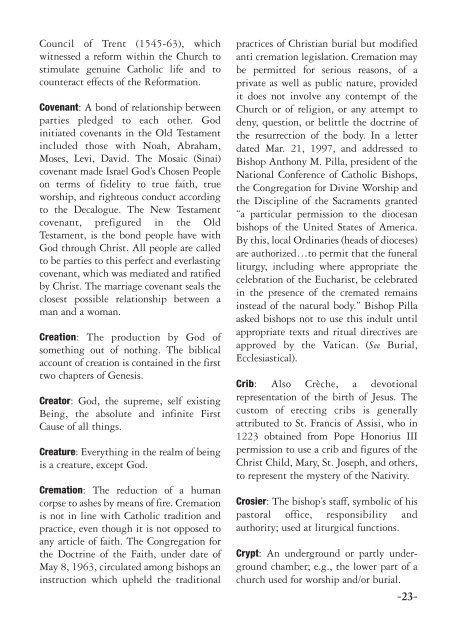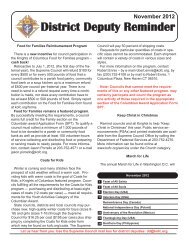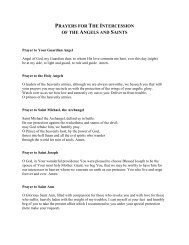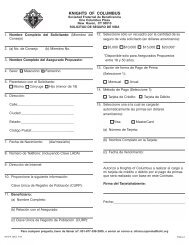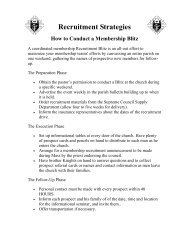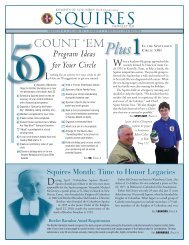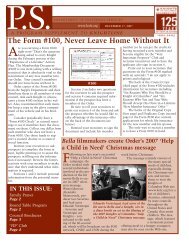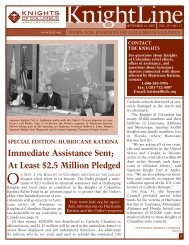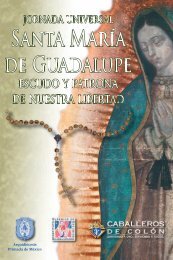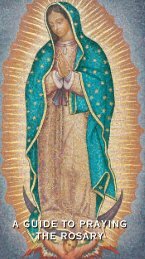CATHOLIC WORD BOOK - Knights of Columbus, Supreme Council
CATHOLIC WORD BOOK - Knights of Columbus, Supreme Council
CATHOLIC WORD BOOK - Knights of Columbus, Supreme Council
Create successful ePaper yourself
Turn your PDF publications into a flip-book with our unique Google optimized e-Paper software.
<strong>Council</strong> <strong>of</strong> Trent (1545-63), which<br />
witnessed a reform within the Church to<br />
stimulate genuine Catholic life and to<br />
counteract effects <strong>of</strong> the Reformation.<br />
Covenant: A bond <strong>of</strong> relationship between<br />
parties pledged to each other. God<br />
initiated covenants in the Old Testament<br />
included those with Noah, Abraham,<br />
Moses, Levi, David. The Mosaic (Sinai)<br />
covenant made Israel God’s Chosen People<br />
on terms <strong>of</strong> fidelity to true faith, true<br />
worship, and righteous conduct according<br />
to the Decalogue. The New Testament<br />
covenant, prefigured in the Old<br />
Testament, is the bond people have with<br />
God through Christ. All people are called<br />
to be parties to this perfect and everlasting<br />
covenant, which was mediated and ratified<br />
by Christ. The marriage covenant seals the<br />
closest possible relationship between a<br />
man and a woman.<br />
Creation: The production by God <strong>of</strong><br />
something out <strong>of</strong> nothing. The biblical<br />
account <strong>of</strong> creation is contained in the first<br />
two chapters <strong>of</strong> Genesis.<br />
Creator: God, the supreme, self existing<br />
Being, the absolute and infinite First<br />
Cause <strong>of</strong> all things.<br />
Creature: Everything in the realm <strong>of</strong> being<br />
is a creature, except God.<br />
Cremation: The reduction <strong>of</strong> a human<br />
corpse to ashes by means <strong>of</strong> fire. Cremation<br />
is not in line with Catholic tradition and<br />
practice, even though it is not opposed to<br />
any article <strong>of</strong> faith. The Congregation for<br />
the Doctrine <strong>of</strong> the Faith, under date <strong>of</strong><br />
May 8, 1963, circulated among bishops an<br />
instruction which upheld the traditional<br />
practices <strong>of</strong> Christian burial but modified<br />
anti cremation legislation. Cremation may<br />
be permitted for serious reasons, <strong>of</strong> a<br />
private as well as public nature, provided<br />
it does not involve any contempt <strong>of</strong> the<br />
Church or <strong>of</strong> religion, or any attempt to<br />
deny, question, or belittle the doctrine <strong>of</strong><br />
the resurrection <strong>of</strong> the body. In a letter<br />
dated Mar. 21, 1997, and addressed to<br />
Bishop Anthony M. Pilla, president <strong>of</strong> the<br />
National Conference <strong>of</strong> Catholic Bishops,<br />
the Congregation for Divine Worship and<br />
the Discipline <strong>of</strong> the Sacraments granted<br />
“a particular permission to the diocesan<br />
bishops <strong>of</strong> the United States <strong>of</strong> America.<br />
By this, local Ordinaries (heads <strong>of</strong> dioceses)<br />
are authorized…to permit that the funeral<br />
liturgy, including where appropriate the<br />
celebration <strong>of</strong> the Eucharist, be celebrated<br />
in the presence <strong>of</strong> the cremated remains<br />
instead <strong>of</strong> the natural body.” Bishop Pilla<br />
asked bishops not to use this indult until<br />
appropriate texts and ritual directives are<br />
approved by the Vatican. (See Burial,<br />
Ecclesiastical).<br />
Crib: Also Crèche, a devotional<br />
representation <strong>of</strong> the birth <strong>of</strong> Jesus. The<br />
custom <strong>of</strong> erecting cribs is generally<br />
attributed to St. Francis <strong>of</strong> Assisi, who in<br />
1223 obtained from Pope Honorius III<br />
permission to use a crib and figures <strong>of</strong> the<br />
Christ Child, Mary, St. Joseph, and others,<br />
to represent the mystery <strong>of</strong> the Nativity.<br />
Crosier: The bishop’s staff, symbolic <strong>of</strong> his<br />
pastoral <strong>of</strong>fice, responsibility and<br />
authority; used at liturgical functions.<br />
Crypt: An underground or partly under -<br />
ground chamber; e.g., the lower part <strong>of</strong> a<br />
church used for worship and/or burial.<br />
-23-


